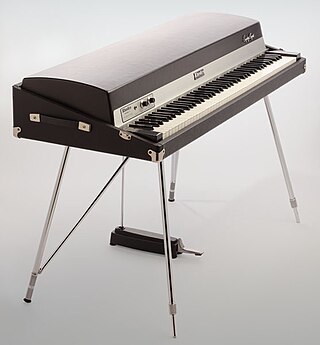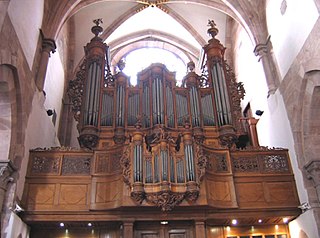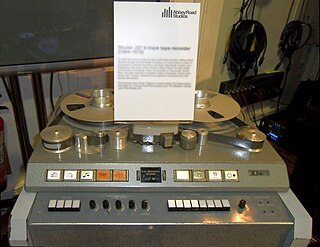
In music, an arrangement is a musical adaptation of an existing composition. Differences from the original composition may include reharmonization, melodic paraphrasing, orchestration, or formal development. Arranging differs from orchestration in that the latter process is limited to the assignment of notes to instruments for performance by an orchestra, concert band, or other musical ensemble. Arranging "involves adding compositional techniques, such as new thematic material for introductions, transitions, or modulations, and endings. Arranging is the art of giving an existing melody musical variety". In jazz, a memorized (unwritten) arrangement of a new or pre-existing composition is known as a head arrangement.

The double bass, also known simply as the bass, amongst other names, is the largest and lowest-pitched string instrument in the modern symphony orchestra. Similar in structure to the cello, it has four, although occasionally five, strings.

An electronic musical instrument or electrophone is a musical instrument that produces sound using electronic circuitry. Such an instrument sounds by outputting an electrical, electronic or digital audio signal that ultimately is plugged into a power amplifier which drives a loudspeaker, creating the sound heard by the performer and listener.

Music is generally defined as the art of arranging sound to create some combination of form, harmony, melody, rhythm or otherwise expressive content. Exact definitions of music vary considerably around the world, though it is an aspect of all human societies, a cultural universal. While scholars agree that music is defined by a few specific elements, there is no consensus on their precise definitions. The creation of music is commonly divided into musical composition, musical improvisation, and musical performance, though the topic itself extends into academic disciplines, criticism, philosophy, and psychology. Music may be performed or improvised using a vast range of instruments, including the human voice.

The piano is a keyboard instrument with strings struck by wooden hammers coated with a softer material. It is played using its keyboard, which is a row of keys touched by the performer with the fingers and thumbs of both hands, causing the hammers to strike the strings. It was invented in Italy by Bartolomeo Cristofori around the year 1700.

The Rhodes piano is an electric piano invented by Harold Rhodes, which became popular in the 1970s. Like a conventional piano, the Rhodes generates sound with keys and hammers, but instead of strings, the hammers strike thin metal tines, which vibrate next to an electromagnetic pickup. The signal is then sent through a cable to an external keyboard amplifier and speaker.

Musical composition can refer to an original piece or work of music, either vocal or instrumental, the structure of a musical piece or to the process of creating or writing a new piece of music. People who create new compositions are called composers. Composers of primarily songs are usually called songwriters; with songs, the person who writes lyrics for a song is the lyricist. In many cultures, including Western classical music, the act of composing typically includes the creation of music notation, such as a sheet music "score," which is then performed by the composer or by other musicians. In popular music and traditional music, songwriting may involve the creation of a basic outline of the song, called the lead sheet, which sets out the melody, lyrics and chord progression. In classical music, orchestration is typically done by the composer, but in musical theatre and in pop music, songwriters may hire an arranger to do the orchestration. In some cases, a pop or traditional songwriter may not use written notation at all and instead compose the song in their mind and then play, sing or record it from memory. In jazz and popular music, notable sound recordings by influential performers are given the weight that written or printed scores play in classical music.

String instruments, stringed instruments, or chordophones are musical instruments that produce sound from vibrating strings when a performer plays or sounds the strings in some manner.
Sheet music is a handwritten or printed form of musical notation that uses musical symbols to indicate the pitches, rhythms, or chords of a song or instrumental musical piece. Like its analogs – printed books or pamphlets in English, Arabic, or other languages – the medium of sheet music typically is paper. However, access to musical notation since the 1980s has included the presentation of musical notation on computer screens and the development of scorewriter computer programs that can notate a song or piece electronically, and, in some cases, "play back" the notated music using a synthesizer or virtual instruments.

In music, the organ is a keyboard instrument of one or more pipe divisions or other means for producing tones. The organs have usually two or three, up to five manuals, for playing with the hands, and pedalboard, with the feet. With the use of registers, several groups of pipes can be connected to one manual.

Keith Jarrett is an American jazz and classical music pianist and composer. Jarrett started his career with Art Blakey and later moved on to play with Charles Lloyd and Miles Davis. Since the early 1970s, he has also been a group leader and solo performer in jazz, jazz fusion, and classical music. His improvisations draw from the traditions of jazz and other genres, including Western classical music, gospel, blues, and ethnic folk music.

An electric piano is a musical instrument which produces sounds when a performer presses the keys of a piano-style musical keyboard. Pressing keys causes mechanical hammers to strike metal strings, metal reeds or wire tines, leading to vibrations which are converted into electrical signals by magnetic pickups, which are then connected to an instrument amplifier and loudspeaker to make a sound loud enough for the performer and audience to hear. Unlike a synthesizer, the electric piano is not an electronic instrument. Instead, it is an electro-mechanical instrument. Some early electric pianos used lengths of wire to produce the tone, like a traditional piano. Smaller electric pianos used short slivers of steel to produce the tone. The earliest electric pianos were invented in the late 1920s; the 1929 Neo-Bechstein electric grand piano was among the first. Probably the earliest stringless model was Lloyd Loar's Vivi-Tone Clavier. A few other noteworthy producers of electric pianos include Baldwin Piano and Organ Company and the Wurlitzer Company.

An electronic keyboard, portable keyboard, or digital keyboard is an electronic musical instrument, an electronic derivative of keyboard instruments. Electronic keyboards include synthesizers, digital pianos, stage pianos, electronic organs and digital audio workstations. In technical terms, an electronic keyboard is a synthesizer with a low-wattage power amplifier and small loudspeakers.

A rhythm section is a group of musicians within a music ensemble or band that provides the underlying rhythm, harmony and pulse of the accompaniment, providing a rhythmic and harmonic reference and "beat" for the rest of the band. The rhythm section is often contrasted with the roles of other musicians in the band, such as the lead guitarist or lead vocals whose primary job is to carry the melody.

The bass saxophone is one of the lowest-pitched members of the saxophone family—larger and lower than the more common baritone saxophone. It was likely the first type of saxophone built by Adolphe Sax, as first observed by Berlioz in 1842. It is a transposing instrument pitched in B♭, an octave below the tenor saxophone and a perfect fourth below the baritone saxophone. A bass saxophone in C, intended for orchestral use, was included in Adolphe Sax's patent, but few known examples were built. The bass saxophone is not a commonly used instrument, but it is heard on some 1920s jazz recordings, in free jazz, in saxophone choirs and sextets, and occasionally in concert bands and rock music.

An experimental musical instrument is a musical instrument that modifies or extends an existing instrument or class of instruments, or defines or creates a new class of instrument. Some are created through simple modifications, such as cracked drum cymbals or metal objects inserted between piano strings in a prepared piano. Some experimental instruments are created from household items like a homemade mute for brass instruments such as bathtub plugs. Other experimental instruments are created from electronic spare parts, or by mixing acoustic instruments with electric components.

This is a list of jazz and popular music terms that are likely to be encountered in printed popular music songbooks, fake books and vocal scores, big band scores, jazz, and rock concert reviews, and album liner notes. This glossary includes terms for musical instruments, playing or singing techniques, amplifiers, effects units, sound reinforcement equipment, and recording gear and techniques which are widely used in jazz and popular music. Most of the terms are in English, but in some cases, terms from other languages are encountered.

Music technology is the study or the use of any device, mechanism, machine or tool by a musician or composer to make or perform music; to compose, notate, playback or record songs or pieces; or to analyze or edit music.

Electric music technology refers to musical instruments and recording devices that use electrical circuits, which are often combined with mechanical technologies. Examples of electric musical instruments include the electro-mechanical electric piano, the electric guitar, the electro-mechanical Hammond organ and the electric bass. All of these electric instruments do not produce a sound that is audible by the performer or audience in a performance setting unless they are connected to instrument amplifiers and loudspeaker cabinets, which made them sound loud enough for performers and the audience to hear. Amplifiers and loudspeakers are separate from the instrument in the case of the electric guitar, electric bass and some electric organs and most electric pianos. Some electric organs and electric pianos include the amplifier and speaker cabinet within the main housing for the instrument.

In music production, the recording studio is often treated as a musical instrument when it plays a significant role in the composition of music. Sometimes called "playing the studio", the approach is typically embodied by artists or producers who favor the creative use of studio technology in record production, as opposed to simply documenting live performances in studio. Techniques include the incorporation of non-musical sounds, overdubbing, tape edits, sound synthesis, audio signal processing, and combining segmented performances (takes) into a unified whole.


















